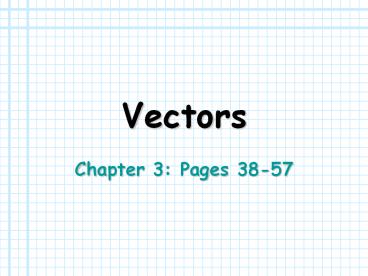Vectors - PowerPoint PPT Presentation
Title:
Vectors
Description:
Vectors Chapter 3: Pages 38-57 – PowerPoint PPT presentation
Number of Views:205
Avg rating:3.0/5.0
Title: Vectors
1
Vectors
- Chapter 3 Pages 38-57
2
Overview
- A vector is a quantity that can be measured in
both a magnitude and a direction
- Common Scalar Quantities
- Mass
- Work
- Energy
- Power
- Temperature
- Electric charge
- Common Vector Quantities
- Displacement
- Velocity
- Acceleration
- Force
3
Geometric Addition and Subtraction of Vectors
- Commutative Law
- a b b a
- Associative Law
- (a b) c a (b c)
- Vector Subtraction
- d a b a (-b)
4
Components of a Vector Resolving the Vectors
- ax a cos(f)
- ay a sin(f)
- a v(ax2 ay2)
- tan(f) ay/ax
5
Unit Vector Notation
- a ax i ay j az k
- b bx i by j bz k
Addition by Components
r a b rx ax bx ry ay by rz az bz
6
MULTIPLICATION!!!
- Vector by scalar
- becomes a new vector of the magnitude of
- s(scalar) a
- the direction is the original direction of vector
a if s is and the opposite direction if s is . - Vector by vector
- Dot product
- Cross Product
7
Dot (scalar) product
- a b abcos(f) where f is the angle between
the directions of a and b - a b (axbx) (ayby) (azbz)
Example Work F d (3.0N)(2.0m)ij
(10.5N)(2.0m)ii (6J)(0) (21J)(1) 21 J
If an object experiences a constant force, F
(3.0N)i (10.5N)j in the direction of (2.0m)j,
what is the work done by the force?
8
Cross (Vector) Product
- a b absin(f) where f is the angle between
the directions of a and b - b a -(a b) does not follow a commutative
rule
b a
i j k
(aybz - azby)i (azbx - axbz)j (axby -
aybx)k
bx by bz
ax ay az
9
Knowledge Questions
- 1-20
10
- What are the formulas for determining components
of a vector?
ax acos(?) ay asin(?)
11
- a b b a is the _______ law of vector
geometric addition.
Commutative Law
12
- When a vector is multiplied by a ______, the
direction changes based on that ________ quantity.
Scalar, scalar
13
- In the formula ab abcos(f), f is
__________________.
Angle between the directions of a and b.
14
- True or False
- (a) a b b a
- (b) a b b a
- False
- True
15
- An example of a scalar quantity is _____ and an
example of a vector quantity is _____. - A) mass, power C) energy, work
- B) acceleration, work D) mass, acceleration
D) mass, acceleration
16
- Give the three letters used in expressing
direction in unit vector notation.
I hat, j hat, k hat
17
- Give the formula for vector subtraction.
d a b a (-b)
18
- A ______ quantity is expressed in both magnitude
and direction.
Vector
19
- The process of finding the components of a vector
is called _______ ___ ______.
Resolving the vector
20
- Values of ax and ay are given. Find the
magnitude of a.
a (ax2 ay2)½
21
- dx -25.0 m
- dy 40.0 m
- What is the magnitude of d?
d v(dx2 dy2) v(2225 m2) 47.2 m
22
- Torque is given by the formula t r F.
- If a radius is given by (3.0 m)i (4.0 m)j and
the F (10N)i (21N)j, find the torque.
T r F (3.0m)(21N) (4.0m)(10N)k (23Nm)k
23
- Angular momentum is expressed as l m(r v).
If an object of mass 200g, and radius (2.0m)i
(2.0m)j is traveling at v (2.0m/s)i (3.0m/s)j
(4.0m/s)k, what is its momentum?
l .200kg(30 42)i (-42 20)j (-22
32)k -1.6 i 1.6 j 2.0 k
24
Free Response
- 1-10
25
- Name the two laws of vector addition and give
their formulas.
Associative Law (a b) c a (b
c) Commutative Law a b b a
26
- Describe two differences between cross and dot
products.
- Dot products follow a commutative rule and cross
products dont - Cross products containing vectors with no k
direction might result in a vector in the k
direction where dot products will not.
27
- Fg 208 N
- ? 30
- Break the force into components.
- Fg
?
Fx Fgcos(?) 180.1 N Fy Fgsin(?) 104 N
28
- A person walks 3.1 km north, 2.4 km west, and 5.2
km south consecutively. A) what is the magnitude
of their displacement? and b) express the
displacement vector in unit-vector notation using
an appropriate coordinate system.
- v(2.4)2 (2.1)2 3.18 km
- (3.1km)i (2.4km)j (5.2km)i (-2.1km)i
(2.4km)j































